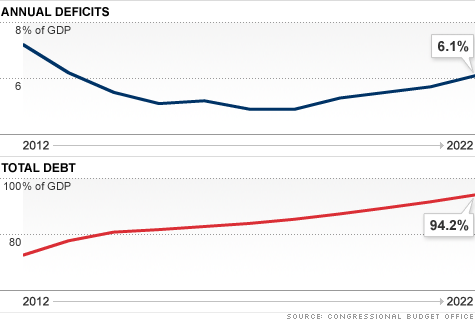Search News

NEW YORK (CNNMoney) -- Federal deficits are expected to fall over the next few years but then start to climb, pushing the nation's accumulated debt to levels not seen since just after World War II, according to new estimates from the Congressional Budget Office released Tuesday.
A big driver of the deficits in the next decade is a series of costly tax and spending decisions that Congress is expected to make.
Those include making the Bush-era tax cuts permanent before they expire at the end of this year; permanently adjusting the Alternative Minimum Tax for inflation to protect the middle class from having to pay it; and permanently preventing a pay cut for Medicare doctors.
Another going assumption: Congress will not let $1.2 trillion in spending cuts mandated under law to take effect starting in 2013.
Under this so-called "alternative fiscal scenario," the CBO notes, deficits would average 5.4% of gross domestic product between 2013 and 2022. In the absence of those policy decisions -- that is, if lawmakers just adhered to current law -- the average would be just 1.5%.
In 2012, the CBO is forecasting a $1.1 trillion deficit, or 7.2% of GDP. That would be nearly two percentage points below last year's deficit.
For years 2013 through 2017, the CBO estimates, deficits will range from $899 billion to $981 billion before climbing back over the $1 trillion mark.
All told, over the next decade the country would add nearly $11 trillion to the debt held by the public, which currently stands at roughly $10.5 trillion. That doesn't include debt owed to government trust funds such as Social Security.
Nearly half of that new debt would result from increased interest costs.
Interest rates have remained very low, but the CBO expects them to increase as the economy recovers. That coupled with growth in the federal debt means the country will spend $5.3 trillion in interest over the next decade.
In 2022 alone, Uncle Sam would owe nearly $900 billion in interest, or 3.6% of GDP.
The CBO report underlines the importance of the fiscal decisions Congress must make this year.
Allowing all the tax cuts to expire and scheduled spending cuts take effect would slow economic growth and increase unemployment somewhat in the next two years, according to the report.
Conversely, if Congress extends the tax cuts and cancels the spending cuts the economy would do somewhat better in the near-term.
For example, the CBO estimates that under the alternative fiscal scenario, real GDP would be between 0.5% and 3.7% higher and unemployment would be between 0.3 to 1.8 percentage points lower in the fourth quarter of 2013.
But the economic effects would be reversed later on. More fiscal restraint now can improve the economy in the long run, while more looser fiscal policies today can be detrimental after a few years.
"Dramatic increases in taxes or cuts in spending ... will tend to hold back the economy [in the near term]," CBO Director Douglas Elmendorf said in a briefing Tuesday. "At the same time, letting the debt skyrocket the way it does in the alternative scenario will ultimately be very, very damaging to the economy and unsupportable [in the long run]."
If lawmakers wanted to boost the economy now and still rein in debt over time, they would need to impose fiscal restraint more slowly, Elmendorf explained. Striking that balance, however, means making big changes from current policies by the end of the decade.
Translation: Lawmakers would need to raise more tax revenue, cut entitlement spending or do some combination of the two.
And there's no advantage in waiting to make those tough choices, Elmendorf said.
"The longer that we wait as a country to make the sort of choices that we have to make, the harder it will be to make them because more debt will have accumulated, because people will then have less time to plan how they will react to these various changes." ![]()
| Overnight Avg Rate | Latest | Change | Last Week |
|---|---|---|---|
| 30 yr fixed | 3.80% | 3.88% | |
| 15 yr fixed | 3.20% | 3.23% | |
| 5/1 ARM | 3.84% | 3.88% | |
| 30 yr refi | 3.82% | 3.93% | |
| 15 yr refi | 3.20% | 3.23% |
Today's featured rates:
| Latest Report | Next Update |
|---|---|
| Home prices | Aug 28 |
| Consumer confidence | Aug 28 |
| GDP | Aug 29 |
| Manufacturing (ISM) | Sept 4 |
| Jobs | Sept 7 |
| Inflation (CPI) | Sept 14 |
| Retail sales | Sept 14 |